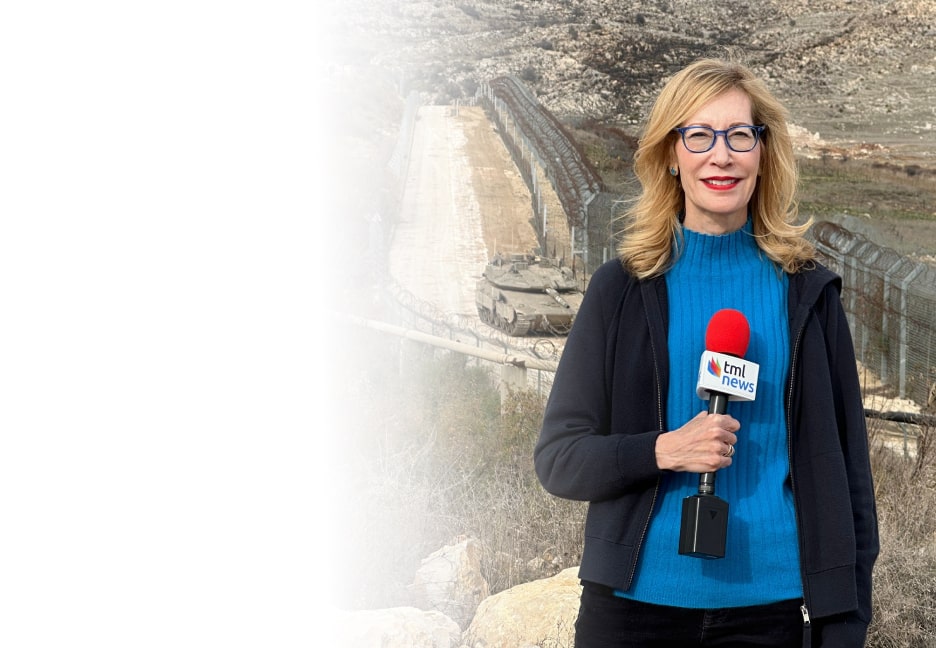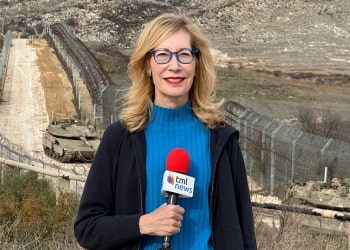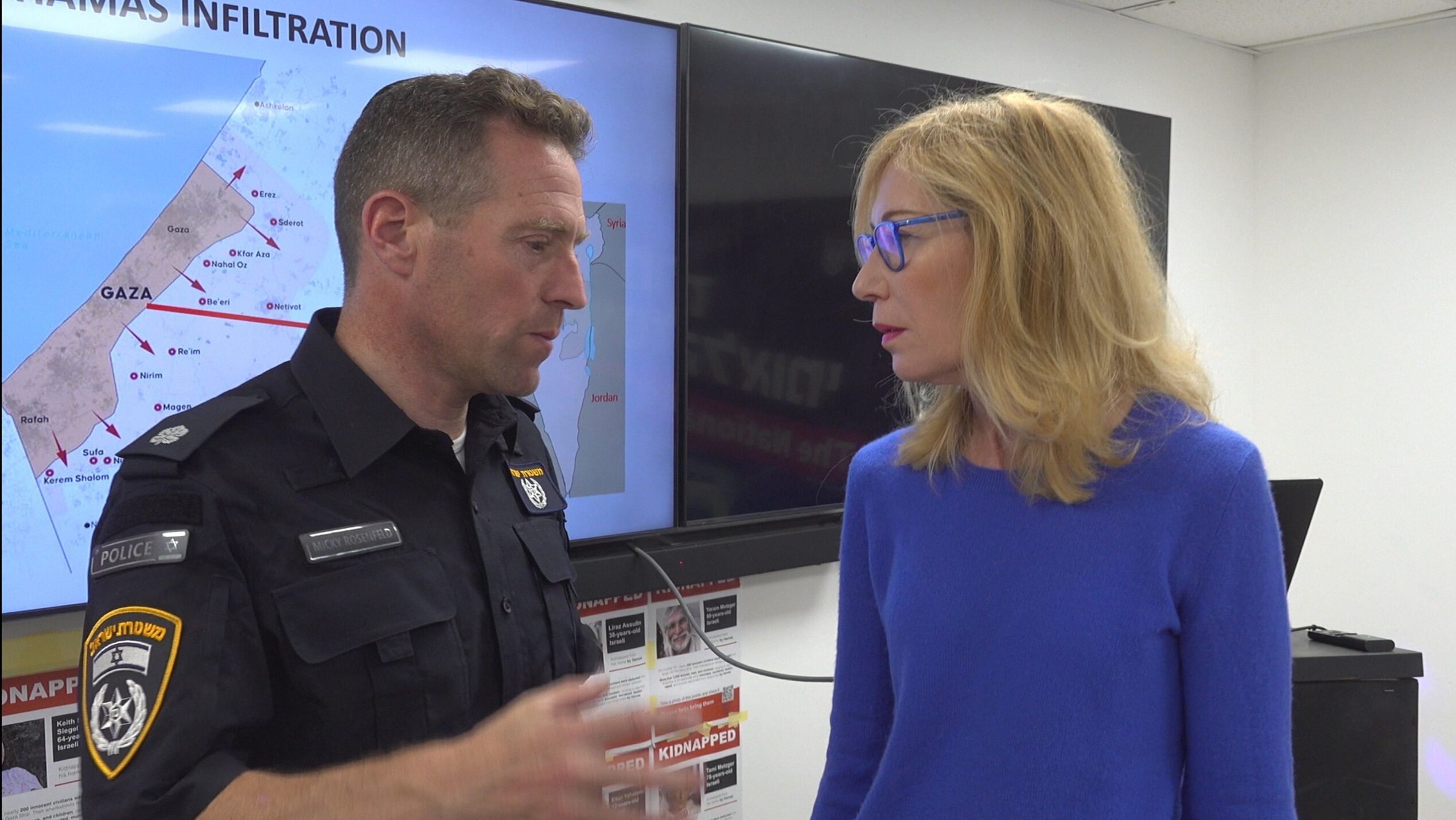Supt. Micky Rosenfeld to TML: Palestinian Workers in Israel Aided Hamas Terrorists in Planning October 7 Infiltration
The head of international coordination for the Israel Police reveals Hamas used detailed local intelligence and describes comprehensive strategy of Hamas during attack
In a temporary police station in the city of Sderot, Superintendent Micky Rosenfeld, head of international coordination for the Israel Police, briefed a group of European parliamentarians who came to Israel through Elnet, an organization that promotes close relations between Europe and Israel, based on shared democratic values and strategic interests. He spoke about the events of October 7.
Rosenfeld explained that before the “black sabbath,” Sderot had 30,000 residents; now, only 2,000 remain—and those that stayed are primarily on the police force or municipal workers. Those who have left are living with friends or relatives or have been taken to hotels in other areas of the country.
The terrorists were well prepared with intelligence. They came with maps to locate police stations; they knew where and how to disconnect electricity on army bases—right down to knowing which wires to cut. They knew the location of the observation and command center, which they infiltrated and destroyed.
The terrorists had detailed information about the kibbutzim that included the number of people, and names of people, living in specific houses.
Sadly, the Israelis learned that Palestinian neighbors and trusted workers provided much of the detailed information to Hamas. Only now did they realize the extent to which residents of the Arab periphery supported and aided the terrorists.
Supt. Micky Rosenfeld served a decade in the elite counterterrorism unit, YAMAM, specializing in operations and intelligence. Rosenfeld had been responsible for coverage of all major terrorist attacks across Israel, corresponding with foreign media and local press.
Rosenfeld is the liaison of the Israel National Police to foreign delegations, law enforcement agencies, homeland security, and VIPs from around the world. British-born, Rosenfeld served in Israel’s elite Givati infantry brigade.
The Media Line’s Felice Friedson spoke with Superintendent Rosenfeld.
TML: Micky Rosenfeld, can you describe October 7 in terms of the infiltration on the border into the various kibbutzim?
Supt. Rosenfeld: What took place on the 7th of October here in Israel is that the Hamas infiltrated at over 21 different points. We know 22 different points. They made their way through the security fence. They used explosive devices in order to get through the different areas, and gradually made their way, which took them about 15 minutes, to enter the first perimeter of the bases and in fact start to kill and shoot at IDF soldiers as well as innocent people in the different kibbutzim and communities around the Gaza Strip area.
All of that was done by firing thousands of rockets inside Israel, and at those same moments, the first 15 minutes, the majority of people took cover and went into those safe zones, safe areas which was the actual drill. And using that 15 minutes, they managed to storm and break down the first lines of the IDF and enter those areas.
This holiday season, give to:
Truth and understanding
The Media Line's intrepid correspondents are in Israel, Gaza, Lebanon, Syria and Pakistan providing first-person reporting.
They all said they cover it.
We see it.
We report with just one agenda: the truth.


TML: A hundred of the 239 hostages are now out. What is the biggest concern at the moment in terms of getting back those hostages, trying to seal borders, and is the police involved in terms of sealing the borders and communities as well?
Supt. Rosenfeld: First of all, we want Israel to get back all of those hostages alive as quick as possible. That is one of the main aims which is of course adjacent to the aim of taking down the Hamas and wiping out the Hamas and prevent any further threat to the southern part of Israel. So, we are working on two levels at the moment.
In terms of the Israeli National Police, our units were the first units to respond both in terms of counterterrorism units and engage with those terrorists who we know and we’ve confirmed intended on making their way into the heart of Israel. They wanted to reach the Judea and Samaria area. They wanted to reach Tel Aviv. They wanted to reach Ashdod. And they wanted to wipe out and kill as many people as possible, but our units responded that morning.
Unfortunately, 58 police officers were killed in the line of duty from our counterterrorism units, from our tactical units. Just to give you an example, one of our YAMAM teams killed over 200 terrorists, but with such a huge number, such a horrific infiltration with the intentions of Hamas to slaughter women and children and murder so many people, this is something that Israel has not gone through since in fact the Holocaust.
TML: The details coming out, the minutiae of the maps; names of families; names of dogs; roads; there was full-scale months of planning here. How do you think this information was obtained?
Supt. Rosenfeld: From what we know from the local residents, number one, the information was received by Gazans that had come inside Israel with documents, and they were allowed and permitted to come in. And they had worked for many months and many years inside the communities as gardeners, as helping support the communities.
They knew who lived in which house. They knew exactly how many people were in those houses, and all of that information they transferred to the Hamas terrorists. And the Hamas terrorists used that information on that same horrific morning to knock on the doors of houses, pull out women and children, shoot them at close range, [and] murder as many people as possible.
We also confirmed and found maps on those terrorists. When they infiltrated the police station here in Sderot, they had maps. They knew exactly that they were going to go to the police station. They didn’t just arrive at the police station. They murdered and they infiltrated, and that’s exactly what they did.
TML: There was a recent incident in the entrance to Jerusalem, and several terrorists got out of their car and they just started shooting people by a bus station. Do you feel that these were locals, or that these were a part of the Hamas infrastructure?
Supt. Rosenfeld: We know and confirm that the terrorist attack that took place at the entrance to Jerusalem was carried out by two residents of Sur Bahir, which is in East Jerusalem. They are affiliated with Hamas. They sat in jail and served time for being involved in terrorist activity. This is something we’re working on 24/7 in Judea and Samaria as well as inside Jerusalem to find those next potential terrorists.
We are arresting them, as well as engaging in them in the West Bank where we’ve seen an increase of police counterterrorism activities as well as IDF activities since October the 7th in the West Bank.
TML: As part of the hostage swap, there were many Palestinian prisoners let out, so do you feel that it’s a sort of cat-and-mouse situation where you’re constantly running after some of the same perpetrators?
Supt. Rosenfeld: Israel is willing to pay a heavy price in order to get back its loved ones [including] the women and children that are being held and are unfortunately at gunpoint right now by the Hamas. We are willing to swap and give up many many prisoners, because there is no other way at the moment.
If we had the military and operational and counterterrorism opportunity, we will take it, but at the moment, due to the complicated situation inside the Gaza Strip, and the most [likely] probability that they are being held in the tunnels, it’s very difficult to reach a tactical situation within a few seconds where you can enter, engage, and shoot the terrorists and save those hostages.
TML: That morning of October 7, some of the numbers coming out were greater. Some were claiming 3,000 to 4,000 people [infiltrated and] that there were warlords; that there were leaders of terrorist organizations. Is the number 1,500 or is the number 3,000?
Supt. Rosenfeld: We know the first initial breach by the Hamas terrorists was more than 900 [people]. Then we know that a further 600 entered with them a few minutes later, and then, after about 9 o’clock in the morning, a further 1,500 armed terrorists as well as local residents, made their way into houses, stole, murdered, and did whatever they wanted.
So, we know there was a complete infiltration of more than 3,000 [Gazan] residents as well as terrorists who were working together [with them].
TML: Are you confident that these terrorists are all accounted for?
Supt. Rosenfeld: They are all accounted for in terms of inside Israel. Yes. There are no further threats inside Israel in terms of terrorists [from Gaza] inside Israel. We are still searching and looking for possible terrorists who we shot and killed inside the Gaza Strip, and I’m talking about the open areas [such as] sand dunes where we’ve both discovered terrorists as well as Israelis.
So, that is something that is ongoing. We’re talking about a large area. We’re talking about 40 kilometers, so that is something that is taking place, but that is not the main activity and operation at the moment. And of course, inside the Gaza Strip itself, the IDF is continuing to use intelligence and focus on finding the terrorists who were involved in the attack and then returned and managed to succeed and make their way [back] into the Gaza Strip. Those terrorists will be killed.

